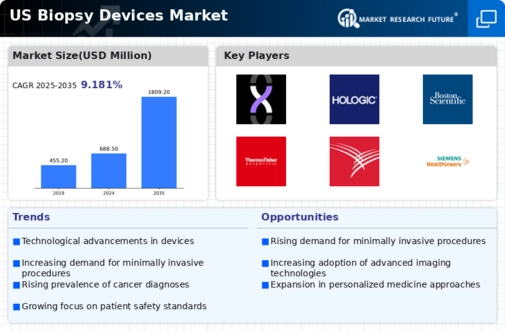Growing Geriatric Population
The growing geriatric population in the United States is a significant driver for the biopsy devices market. As individuals age, the risk of developing various health conditions, including cancer, increases. The U.S. Census Bureau projects that by 2030, all baby boomers will be older than 65, leading to a substantial rise in healthcare needs. This demographic shift is likely to result in an increased demand for diagnostic procedures, including biopsies, to manage age-related diseases effectively. Consequently, the biopsy devices market is expected to expand as healthcare systems adapt to cater to the needs of an aging population, ensuring timely and accurate diagnoses through advanced biopsy techniques.
Rising Healthcare Expenditure
Rising healthcare expenditure in the United States is another critical driver for the biopsy devices market. With healthcare spending projected to reach $6 trillion by 2027, there is a growing emphasis on investing in advanced medical technologies, including biopsy devices. This increase in funding allows healthcare facilities to acquire state-of-the-art equipment and improve diagnostic capabilities. Furthermore, as insurance coverage expands and more patients gain access to healthcare services, the demand for biopsy procedures is likely to rise. The biopsy devices market stands to benefit from this trend, as increased healthcare expenditure facilitates the adoption of innovative biopsy technologies, ultimately enhancing patient care and outcomes.
Increasing Incidence of Cancer
The rising incidence of cancer in the United States is a primary driver for the biopsy devices market. According to the American Cancer Society, approximately 1.9 million new cancer cases are expected to be diagnosed in 2025. This alarming trend necessitates the use of biopsy devices for accurate diagnosis and treatment planning. As healthcare providers seek to improve patient outcomes, the demand for advanced biopsy techniques is likely to increase. The biopsy devices market is thus positioned to benefit from this growing need, as early detection through biopsies can significantly enhance survival rates. Furthermore, the increasing awareness of cancer screening programs is expected to further propel the market, as more individuals seek diagnostic procedures to identify potential malignancies at an earlier stage.
Enhanced Awareness and Education
Enhanced awareness and education regarding the importance of early cancer detection are driving the biopsy devices market. Public health campaigns and educational initiatives have significantly increased knowledge about the benefits of regular screenings and biopsies. As individuals become more informed about their health, they are more likely to seek diagnostic procedures, leading to a higher demand for biopsy devices. This trend is particularly evident in high-risk populations, where proactive health management is crucial. The biopsy devices market is thus experiencing growth as healthcare providers respond to this heightened awareness by offering more accessible and advanced biopsy options, ultimately contributing to improved patient outcomes.
Technological Innovations in Biopsy Devices
Technological innovations are transforming the biopsy devices market, leading to enhanced accuracy and efficiency in diagnostic procedures. Recent advancements include the development of automated biopsy systems and imaging-guided techniques, which improve the precision of tissue sampling. The integration of artificial intelligence in imaging analysis is also gaining traction, potentially increasing the reliability of biopsy results. As a result, healthcare providers are increasingly adopting these advanced technologies, which could lead to a projected market growth of approximately 8% annually over the next five years. The biopsy devices market is thus experiencing a paradigm shift, as these innovations not only streamline the biopsy process but also enhance patient safety and comfort.




















Leave a Comment